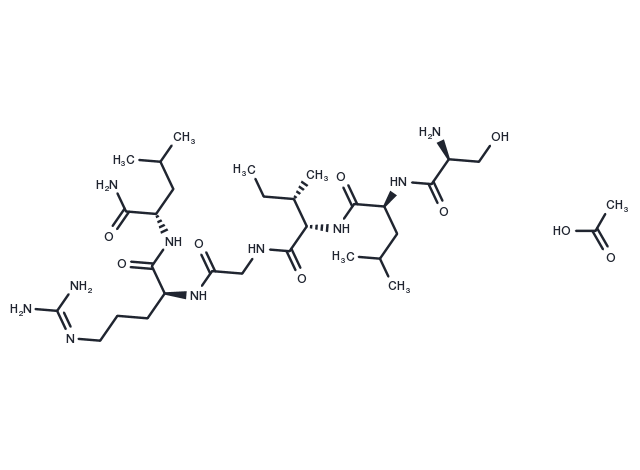keep away from moisture
Powder: -20°C for 3 years | In solvent: -80°C for 1 year

PAR-2 Activating Peptide acetate (SLIGRL-NH2 acetate) is an agonist of Protease-Activated Receptor-2 (PAR-2).

| Pack Size | Availability | Price/USD | Quantity |
|---|---|---|---|
| 1 mg | In stock | $ 78.00 | |
| 5 mg | In stock | $ 205.00 | |
| 10 mg | In stock | $ 367.00 | |
| 25 mg | In stock | $ 619.00 | |
| 50 mg | In stock | $ 879.00 | |
| 100 mg | In stock | $ 1,190.00 | |
| 500 mg | In stock | $ 2,420.00 |


| Description | PAR-2 Activating Peptide acetate (SLIGRL-NH2 acetate) is an agonist of Protease-Activated Receptor-2 (PAR-2). |
| In vitro | Protease-Activated Receptor-2 Activating Peptide (SLIGRL-NH2) is an agonist of PAR-2 and MrgprC11[1]. Protease-Activated Receptor-2 Activating Peptide (SLIGRL-NH2) causes an L-NAME-inhibited relaxation. Based on SLIGRL-NH2 causing a concentration-dependent relaxation with an EC50 of 10 μM in endothelium-free preparations in the presence of perivascular adipose tissue (PVAT) , 20 μM is used as a suitable ‘test’ concentration of peptide in subsequent experiments designed to evaluate the effects of potential inhibitors of ADRF release/action. In the endothelium-free aorta preparations, SLIGRL-NH2 causes a concentration-dependent relaxation in preparations only in the presence of PVAT [+PVAT, -ENDO (endothelium)][2]. |
| Synonyms | SLIGRL-NH2 acetate, PAR-2 Activating Peptide acetate(171436-38-7 free base), Protease-Activated Receptor-2 Activating Peptide acetate |
| Molecular Weight | 716.88 |
| Formula | C31H60N10O9 |
| CAS No. | TP1046L |
keep away from moisture
Powder: -20°C for 3 years | In solvent: -80°C for 1 year
DMSO: 10 mM
You can also refer to dose conversion for different animals. More
bottom
Please see Inhibitor Handling Instructions for more frequently ask questions. Topics include: how to prepare stock solutions, how to store products, and cautions on cell-based assays & animal experiments, etc.
PAR-2 Activating Peptide acetate TP1046L GPCR/G Protein Protease-activated Receptor SLIGRL-NH2 acetate PAR-2 Activating Peptide acetate(171436-38-7 free base) PAR2 Activating Peptide acetate SLIGRL-NH2 Acetate PAR 2 Activating Peptide acetate Protease-Activated Receptor-2 Activating Peptide acetate PAR-2 Activating Peptide Acetate inhibitor inhibit
